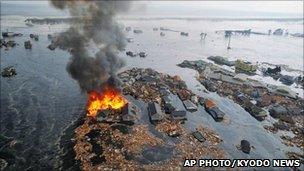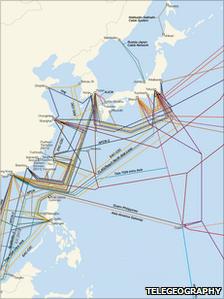Japan earthquake disrupts technology companies
- Published

As Japan counts the human cost of the earthquake, manufacturers are struggling to continue production.
Technology firms are facing major disruption to supplies in the wake of the earthquake and tsunami which have devastated parts of Japan.
The country is home to several of the world's major high tech manufacturers.
Many of them have had to stop production to carry out safety checks and the prospect of rolling blackouts means further interruptions are likely over the coming weeks.
Sony, Panasonic, Toshiba and Canon are among the companies affected.
Panasonic Corp said ongoing aftershocks had prevented it from inspecting two factories in northern Japan.
Sony confirmed that it had voluntarily suspended operations at seven manufacturing plants, while the country assesses the state of its power grid.
The company's Sendai Technology Centre in Tagajo, Miyagi Prefecture has also been closed due to earthquake damage.
Rolling blackouts
Shin-Etsu Chemical, which makes the silicon wafers used in semiconductors, suspended operations at three factories. Two of which have now resumed production.
The firm said operations at its Gunma complex will be affected if the Tokyo Electric Power Company implements rolling blackouts.
Toshiba, which makes around a third of the world's NAND memory chips - found in devices such as Apple's iPad - said on Monday that it was restarting a chip factory in Iwate, northern Japan.
Even so, spot prices for 16-gigabit NAND flash memory chips rose sharply - up 12.5% from the close on 11 March, according to DRAMeXchange, Asia's largest spot market for chips.

Damage to sub sea cables could have disrupted the global internet
Elsewhere, Canon said three of its plants had sustained serious damage in the earthquake. The factories make LCD screens, lenses and inkjet printers.
Internet hub
While the Japanese high tech industry is struggling to get back on its feet, much of the fixed communications infrastructure has survived remarkably intact.
The seas around Japan are a major hub for undersea telecoms cables, forming a critical part of the global internet.
According to Stephan Beckert, an analyst with telecoms research group TeleGeography, several sub sea cables have been damaged as a result of the earthquake.
"All of the outages appear to be on cable segments that land in the Ajigaura or Kitaibaraki landing stations, approximately halfway between Tokyo and Sendai," he told BBC News.
"Fortunately, most of Japan's cable landing stations are well to the South of Tokyo, or on other side of the sheltered inlet that becomes Tokyo Bay," he added.
That has meant that internet services have been largely unaffected by the disaster.
"There is no significant impact on overall traffic volumes in or through the region," said Craig Labovitz, chief scientist at internet monitoring firm Arbor Networks.
Nevertheless, other parts of Japan's communication infrastructure have been damaged.
Telephone operator NTT East Japan said 879,000 telephony lines were out of service, as well as 475,400 fibre-optic lines.
Meanwhile, more than 11,000 wireless base stations belonging to DoCoMo, KDDI and Softbank were also out of service as of Sunday morning, Telegeography reported.
- Published14 March 2011
- Published12 March 2011
- Published12 March 2011
- Published11 March 2011